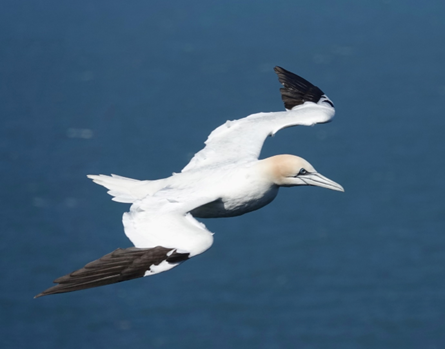#41 Gannet by Geoff Dobbs
Meet Geoff Dobbs, author, naturalist, and birder!
Meet Geoff Dobbs, formerly Chair of the Bird Section of the Yorkshire Naturalists’ Union and author of a forthcoming book on the Birds of Yorkshire. Geoff began birdwatching in the early 1960s when family holidays to static caravans on farms at Sleights near Whitby, Grassington in the Yorkshire Dales and Skelwith Fold in the Lake District sparked his interest in the local birdlife and helped him complete his book I-Spy Birds. His first role was as Junior Recorder for the Hull Scientific and Field Naturalists Club prior to University, as he made regular counts of the ducks in his local park. Later he established and Chaired the Hull Valley Wildlife Group based at Tophill Low Nature Reserve; became East Yorkshire Bird Recorder for the Yorkshire Naturalists’ Union (YNU) from 1998 to 2021; Chair of the YNU Birds Section and Editor of the Yorkshire Bird Report 1997-2005 and 2014 to 2019 and acted as BTO Regional Representative for Hull and East Yorkshire, organising many breeding bird surveys.
Gannet in flight (c) Geoff Dobbs
Geoff’s chosen bird is the Gannet Morus bassanus, Britain’s largest seabird, a species he first saw flying over the sea at Spurn Point on 23rd July 1966. The following year, 1967, he made his first visit to Bempton Cliffs to see the small breeding colony established there, the most southerly on the east coast of Britain. The first mention of the Gannet in Yorkshire appears to refer to a specimen taken alive at Booth Deane near Halifax in October 1831, but in 1924 a pair was seen on Bempton cliffs, and a nest was made the following year, though it was not until 1937 that it could be definitively claimed that eggs were laid. One young was raised in 1949; in 1953, three pairs reared one young; four young were reared in 1958 and six young each year from 1960-62. In 1969, when the RSPB began surveys, there were only 22 pairs. In 1967 the colony seemed very small and distant, but Geoff was still impressed with the huge white cliffs and watched the Gannets as wheeled around the cliffs. Many hours sea-watching off Flamborough Head and visits to Bempton have only confirmed Gannets as one of Geoff’s favourite birds.
Why? Adult Gannets are large (they have a two-metre wingspan) and bright white with black wingtips. The head and nape are yellow. They are distinctively shaped with a long neck and long pointed beak, long pointed tail, and long pointed wings. Both eyes face forwards to give binocular vision, which adds to their appealing if sometimes cross-eyed look. However, it is their feeding action which is so spectacular: they feed by flying high at up to 30metres and circling before plunging into the sea at speed, folding their wings to form a vertical torpedo, often in groups if they have found a shoal of fish. Gannets can achieve speeds of 100 km/h (60 mph) as they strike the water, enabling them to catch fish at a much greater depth than most airborne birds. They bob back up to the surface because they have air sacs in the face and chest under the skin, which act like bubble wrap, cushioning the impact with the water. Bryan Nelson’s 1978 monograph The Gannet, Poyser, is an essential read for more information about their breeding biology.
The Bempton colony is a noisy, pungent place to visit, with birds often close to the observer when gathering nesting material from the clifftops or coasting effortlessly in the updraft. In 2022 it attracted a Black-browed Albatross. Gannets lay one egg, and the brown young look very different, adult plumage finally achieved in their fourth year. Average lifespan is 17 years, although the oldest recorded was 37 years old. After the breeding season, most of our Gannets move to winter in the Bay of Biscay or further south to the coasts of west Africa, with some individuals crossing the Equator.
Gannet colony (c) Geoff Dobbs
Much of the world population of this species breeds in the UK or Republic of Ireland. Gannets breed in significant numbers at only a few localities, mostly on offshore islands, and as a result, is an Amber List species in the British list of Birds of Conservation Concern.
The colony at Bempton RSPB has expanded massively since the 1960s, reaching 2500 pairs in 1997 and over 11,000 pairs in 2012. The colony has increased more slowly since, expanding along the cliffs to the north towards Speeton: in 2017, 13,392 apparently occupied nests were counted and assuming continued growth, numbers may now exceed 15,000 pairs. They may soon be running out of room! The slowly growing British population was estimated to be 295,000 pairs in 2013-14, so Bempton now holds c.5% of the British population and is the largest mainland colony in Britain.
Stormy autumn weather on the coast can result in sightings inland, mostly inexperienced juveniles. There were notable influxes in 2007 and 2013, with birds seen in South and West Yorkshire. 2022 saw an outbreak of avian flu in Britain, which particularly affected Gannets breeding in Scotland - one strange result for surviving Gannets is that their blue eyes turned black! The risks of avian flu and depletion of fish stocks remain potential future threats to this species.
Recording and monitoring
Gannets are regularly monitored due to their conservation priority. The world population has been censused several times since the early 1900s, and the Gannet is also part of the British Trust for Ornithology’s ongoing Seabird Monitoring Programme.
Further information and acknowledgements
NEYEDC would like to thank Geoff for his time and expertise in helping to create this blog.
Gannets in flight (c) Geoff Dobbs



